By Mike Smith
I saw it this weekend during a Premier League match. While the announcers seemed disappointed with the effort ( perhaps rightly so at the Premier League level ) the game manager in me was impressed – a deep shot from a rebound which turned out to be more dangerous to the fans 10 rows up behind the goal than the net itself.
While a Premier League player should be able to make the best choice between multiple options at all times, players at lower levels often try to do too much. In fact, regrettably, I have to tell my current team all the time “ We are NOT Barcelona.” ( I may have to change that to Man City this year as a nod to their impressive run ). What I mean is, I want us to win the ball, get in position, create the best chance we can, TAKE the chance and then get back and play defense.
Look at the diagram below for example – the black team has dropped in, won the ball and gotten it to the center mid.
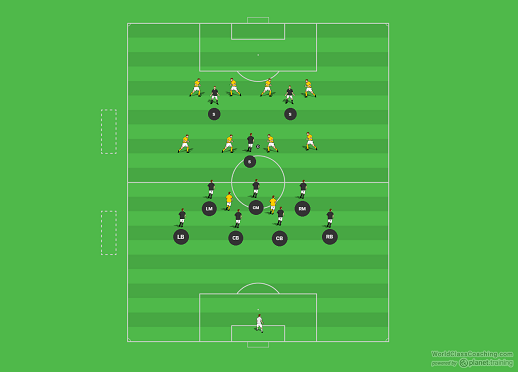
As the next diagram shows, wide support is coming and the attack should be on. Pay attention to the high lighted holding mid.
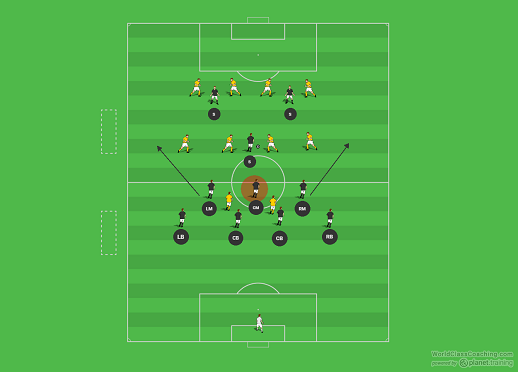
Here ( below ) is the issue. Even though the attack is coming, the defending team has numbers back, is ready to step out and challenge the serve and from a counter attacking perspective, could be ready to surprise the black team.
The key is the holding mid. I coach the tried and true, up the line, serve it in to a near and far post run; it works. BUT, it also leads to the deflections, mis hit services, keeper wins, etc… which can result in counters. PLUS, if the initial attack – which came from exploiting space – doesn’t work, the space is rarely there for another attack. Because of this, I coach my holding player ( sometimes a center back ) to immediately shoot any rebounds very hard and aggressively. This is what happened in the Premier League game.
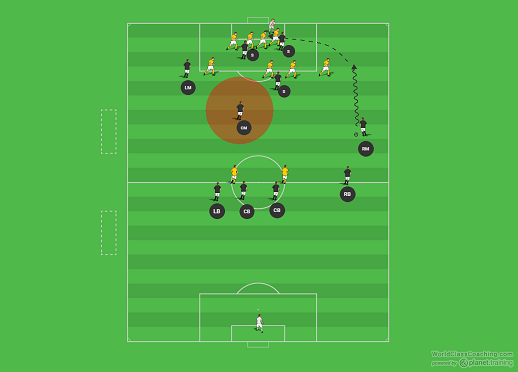
While this approach sometimes seem “ robotic” and limiting to player development and creativity it is very beneficial in teaching players gamesmanship. Why risk getting countered when under extreme pressure? I say send it back – if it misses everyone gets a chance to set up and defend a goal kick BUT: It could go in? It could lead to an own goal? Penalty? Corner? Those all sound like situations which could help a team win right?
I coach this as a system. No matter what the formation or shape or concept, during an attack I ALWAYS want one player to be ready to send in ANY rebounds which come out up the middle. Try this drill to prepare your holding players to hit deeper shots.
Set Up
For me, the best way to practice deep shots is to take some deep shots. It’s good training for the keepers and the players love it. To start, a group of players, each with balls set up 30 – 35 yds out. One player sends the ball in to the keeper on the ground. The keeper sends the ball right back and the shooting player has only 2 touches to corral the ball and send in the shot. This can move fairly quickly and multiple keepers can rotate in.
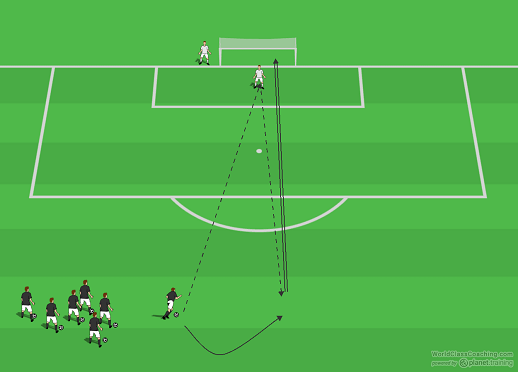
Coaching Points
The main coaching point here is actually making sure the shooting player moves laterally preparing for the rebound and does not let the ball get past. After this point is mastered, move on to the next progression.
Set Up
Add some defenders to the mix and have 2 attackers work together to create the “deflection”. At the top of the keeper box ( as shown ) one defender sends the ball diagonally across the penalty area to a player waiting around the intersection of the arc. This player sends the ball back to the keeper and then bends their run away. The initial defender runs behind the keeper before turning to attack the ball. When the keeper sends the ball out, a second attacker comes in from deep and hits a one touch shot, hopefully before the defender closes down.
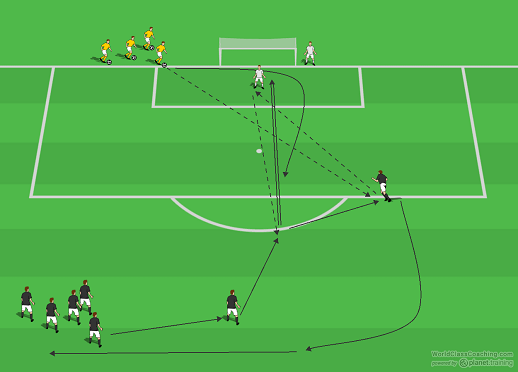
Coaching Points
In a lot of cases, even though the box will be congested right after an attack, this opportunity is there and many times with only one defender to close down. Quick, hard, accurate one touch shots are the idea. The coach should make sure the shooter gets over the ball, hits through it and does everything they can to keep it down and in play. While a ball over the bar ends the play and prevents a counter, the real “goal” is a chance at another attack or a score itself.
By Mike Smith
Currently the Head Coach for University Heights Academy Boys Soccer in Hopkinsville, KY , Mike is in his 14th year as a high school head coach with 23 years coaching experience overall and 34 year as a student and fan of the game. He holds a USSF D License.


